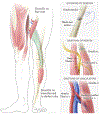Engineering skeletal muscle: Building complexity to achieve functionality
- PMID: 33994095
- PMCID: PMC8918036
- DOI: 10.1016/j.semcdb.2021.04.016
Engineering skeletal muscle: Building complexity to achieve functionality
Abstract
Volumetric muscle loss (VML) VML is defined as the loss of a critical mass of skeletal muscle that overwhelms the muscle's natural healing mechanisms, leaving patients with permanent functional deficits and deformity. The treatment of these defects is complex, as skeletal muscle is a composite structure that relies closely on the action of supporting tissues such as tendons, vasculature, nerves, and bone. The gold standard of treatment for VML injuries, an autologous muscle flap transfer, suffers from many shortcomings but nevertheless remains the best clinically available avenue to restore function. This review will consider the use of composite tissue engineered constructs, with multiple components that act together to replicate the function of an intact muscle, as an alternative to autologous muscle flaps. We will discuss recent advances in the field of tissue engineering that enable skeletal muscle constructs to more closely reproduce the functionality of an autologous muscle flap by incorporating vasculature, promoting innervation, and reconstructing the muscle-tendon boundary. Additionally, our understanding of the cellular composition of skeletal muscle has evolved to recognize the importance of a diverse variety of cell types in muscle regeneration, including fibro/adipogenic progenitors and immune cells like macrophages and regulatory T cells. We will address recent advances in our understanding of how these cell types interact with, and can be incorporated into, implanted tissue engineered constructs.
Keywords: Autologous Muscle Flap Transfer; Innervation; Myotendinous junction; Tissue Engineered Skeletal Muscle; Vascularization; Volumetric Muscle Loss.
Copyright © 2021 Elsevier Ltd. All rights reserved.
Figures


References
-
- Chargé SBP & Rudnicki M. a. Cellular and molecular regu1. Chargé SBP, Rudnicki M a. Cellular and molecular regulation of muscle regeneration. Physiol. Rev 2004;84(1):209–38. Available at: http://www.ncbi.nlm.nih.gov/pubmed/14715915.lation of muscle regeneration. Physiol. Rev. (2004). - PubMed
-
- Correction to: A Murine Model of Volumetric Muscle Loss and a Regenerative Medicine Approach for Tissue Replacement by Sicari BM, Agrawal V, Siu BF, Medberry CJ, Dearth CL, Turner NJ, Badylak SF. Tissue Eng Part A 2012;18(19-20):1941–1948. DOI: 10.1089/ten.tea.2012.0475. - DOI - PMC - PubMed
- Tissue Engineering - Part A vol. 24 (2018).
-
- Corona BT, Wenke JC & Ward CL Pathophysiology of volumetric muscle loss injury. Cells Tissues Organs 202, (2016). - PubMed
-
- Corona BT, Rivera JC, Owens JG, Wenke JC & Rathbone CR Volumetric muscle loss leads to permanent disability following extremity trauma. J. Rehabil. Res. Dev 52, 785–792 (2015). - PubMed
Publication types
MeSH terms
Grants and funding
LinkOut - more resources
Full Text Sources
Other Literature Sources
Medical

